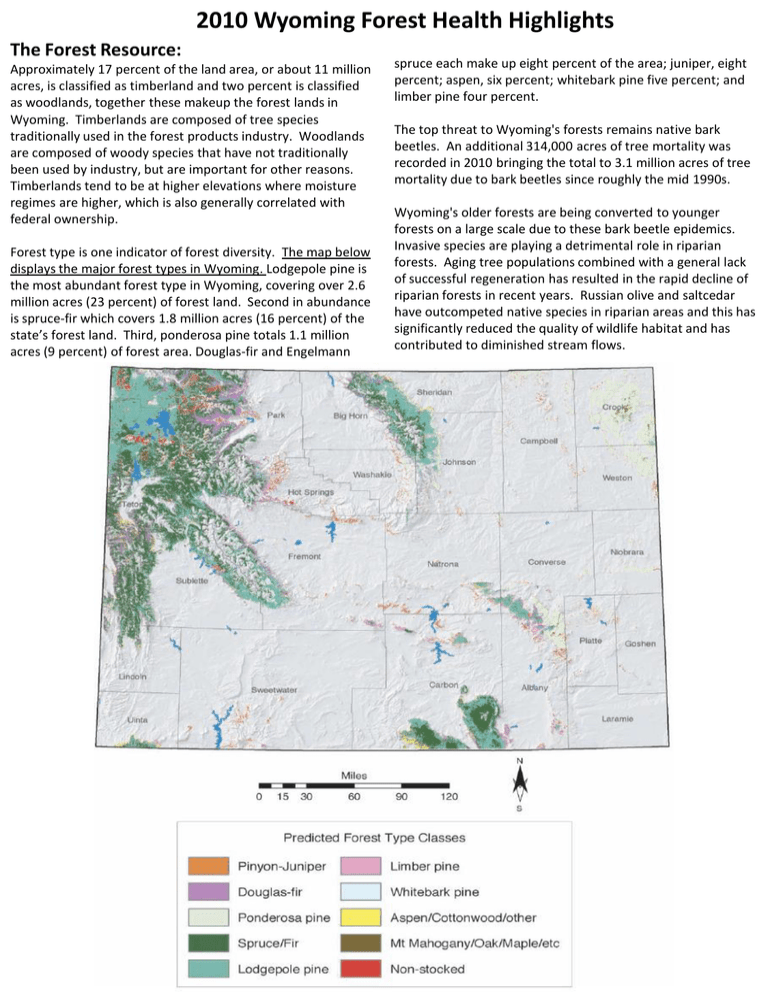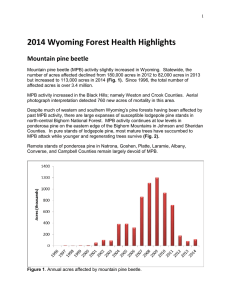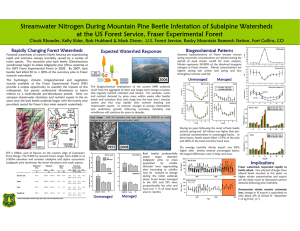2010 Wyoming Forest Health Highlights The Forest Resource:
advertisement

2010 Wyoming Forest Health Highlights The Forest Resource: Approximately 17 percent of the land area, or about 11 million acres, is classified as timberland and two percent is classified as woodlands, together these makeup the forest lands in Wyoming. Timberlands are composed of tree species traditionally used in the forest products industry. Woodlands are composed of woody species that have not traditionally been used by industry, but are important for other reasons. Timberlands tend to be at higher elevations where moisture regimes are higher, which is also generally correlated with federal ownership. Forest type is one indicator of forest diversity. The map below displays the major forest types in Wyoming. Lodgepole pine is the most abundant forest type in Wyoming, covering over 2.6 million acres (23 percent) of forest land. Second in abundance is spruce-fir which covers 1.8 million acres (16 percent) of the state’s forest land. Third, ponderosa pine totals 1.1 million acres (9 percent) of forest area. Douglas-fir and Engelmann spruce each make up eight percent of the area; juniper, eight percent; aspen, six percent; whitebark pine five percent; and limber pine four percent. The top threat to Wyoming's forests remains native bark beetles. An additional 314,000 acres of tree mortality was recorded in 2010 bringing the total to 3.1 million acres of tree mortality due to bark beetles since roughly the mid 1990s. Wyoming's older forests are being converted to younger forests on a large scale due to these bark beetle epidemics. Invasive species are playing a detrimental role in riparian forests. Aging tree populations combined with a general lack of successful regeneration has resulted in the rapid decline of riparian forests in recent years. Russian olive and saltcedar have outcompeted native species in riparian areas and this has significantly reduced the quality of wildlife habitat and has contributed to diminished stream flows. Forest Health Concerns in Wyoming Mountain pine beetle (MPB) Mountain pine beetle intensity varied widely among forests scattered throughout eastern Wyoming. Areas specifically surveyed included Pine Bluffs in southeastern Laramie County; Albin Hills in northeastern Laramie County; Hat Creek Pine Breaks in Niobrara County; Sixtysix Mountain in southeastern Goshen County; Bear Mountain and Goshen Hole Rim in western Goshen County; Old Woman Creek Hills and Buck Creek Hills in Niobrara County; Rawhide Buttes in northwestern Goshen County and southern Niobrara County; and Pine Ridge in western Converse County, northeastern Natrona County, and southeastern Johnson County. No MPB mortality was noticed in the Hat Creek Pine Breaks; an area dominated by ponderosa pine. Past surveys of this area showed some MPB mortality in the Horseshoe Hills immediately adjacent Highway 270 north of Manville and west of the Hat Creek Pine Breaks. Another area dominated by ponderosa pine, namely Pine Ridge, had large areas of past beetle-killed ponderosa pines but no current mortality was noticed along the full expanse of its range. Other areas in eastern Wyoming that showed no signs of current MPB mortality include Sixty-six Mountain, Bear Mountain and Goshen Hole Rim, Old Woman Creek Hills, and Buck Creek Hills. Ponderosa pine in the Rawhide Buttes, Albin Hills, and Pine Bluffs are being impacted by MPB. Although the results appear largely endemic, MPB data collected from the survey of Rawhide Buttes shows most mortality on the eastern edge of the buttes. None of the isolated ‘pockets’ of mortality in the Rawhide Buttes exceeds 10 trees. Pine Bluffs, in southeastern Laramie County, has large numbers of MPB mortality particularly within a range of six miles north of the Wyoming and Colorado border. Tree mortality numbers range from three trees to 40 trees within isolated areas. Very few ponderosa pines were killed by MPB in the Albin Hills; a few small areas of dead trees were observed in the south tips of East Kellehan Creek and West Kellehan Creek. Weston and Crook Counties, were relatively unaffected by MPB as compared to other parts of Wyoming, these counties are now experiencing increased pine mortality believed to be coming from affected areas in South Dakota. Specimen Hill, and Gardner Mountain in western Johnson County as compared to years past. Likewise, the community of Story is not experiencing as dramatic a MPB trend as observed in the past. Most limber pine across the entire expanses of the Rattlesnake Hills, Crooks Mountain, Green Mountain, and Ferris Mountains has been killed by MPB and probably, to some degree, are affected by white pine blister rust as well. Lodgepole pine within and surrounding the communities of Foxpark, Foxborough Estates, Albany, Mountain Home, Keystone, and Ryan Park are suffering large losses due to MPB. The dominant trees are largely lost due to MPB and in most cases, the only remaining lodgepole pines are the co-dominant and suppressed trees. MPB has altered community forests in Wyoming. Due to flight ranges as well as firewood and raw log transport, MPB is now present in many communities like Cheyenne and Rawlins. Mountain Pine Beetle (MPB) outbreaks and epidemics on the National Forests (NF) in Wyoming •On the Bighorn NF there are small pockets of dead lodgepole and ponderosa pines caused by mountain pine beetle. • In North East Wyoming, ponderosa pines were killed by MPB on 400 acres of the Black Hills NF, in Crook and Weston Counties. •On the Medicine Bow NF, MPB has moved through the lodgepole pine and into the ponderosa pine. It is also present in many of the limber pines, so all hosts are impacted by the large epidemic of MPB in South East Wyoming. •On the Shoshone NF – lodgepole, limber, and whitebark pines were killed by MPB. The beetle outbreak is more active in the southern parts of the forest. In some areas all of the 5 needle pines (whitebark, limber) have been killed by MPB. •MPB damage is also great in lodgepole and whitebark pines west of the Continental Divide in WY. Western WY federal lands have thousand of acres impacted by MPB. National Forests: Bridger-Teton (1,500), Caribou-Targhee (235,000), and Wasatch-Cache (13,000), and Yellowstone National Park (41,000). MPB damage to whitebark and limber pines in the Washakie Needles area of the Shoshone NF . Other Insects and Diseases of Concern to Wyoming Forest Health Gypsy moth Wyoming State Forestry Division placed 102 gypsy moth traps in Laramie, Platte, Carbon, Niobrara, Weston, Crook, Fremont, and Natrona Counties. No adult male moths were detected. Spruce & Douglas-fir Beetles Engelmann spruce is not a common species covering the majority of Wyoming State Forestry Division survey area. Most of the Engelmann spruce observed were in the Sugarloaf Mountain area in southwest Hot Springs County and the dominant stems appeared to not be affected by spruce beetle. Most of the dominant Douglas-fir trees on Little Mountain and Pine Mountain as well as on Sugarloaf Mountain have been killed by Douglas-fir beetle. Mortality levels in co-dominant and suppressed trees in these areas are not as high. White Pine Blister Rust Disease White pine blister rust caused mortality is occurring on limber or whitebark pine trees and regeneration across Wyoming. This disease continues to intensify and spread into previously uninfected stands. Although this disease is killing pine throughout the state, mountain pine beetle has recently replaced white pine blister rust as the leading cause of large-tree mortality. A study in the Bighorn National Forest found mountain pine beetle infested trees had higher incidences of branch cankers and stem cankers compared with noninfested trees (64% and 42% verses 49% and 18%, respectively). This study validated the theory that there is a positive correlation between mpb attack and canker severity and location. Outbreaks of spruce beetle and Douglas-fir beetle impacted about 79,000 acres and 7,400 acres respectively on federal forest lands in Wyoming. The majority of this damage was on the Shoshone and the Medicine Bow National Forests. For Forest Health Assistance and further information on Forest Health in Wyoming, please refer to the contacts and websites listed below. http://slf-web.state.wy.us/forestry.aspx Wyoming State Forestry Division 1100 West 22nd St. Cheyenne, WY 82001 (307-777-7586) USDA Forest Service - Rocky Mountain Region Forest Health Protection - Forest Health Monitoring www.fs.usda.gov/goto/r2/fh



